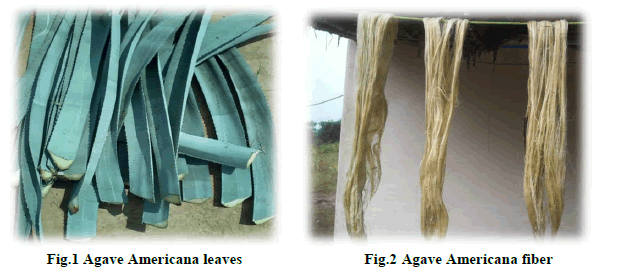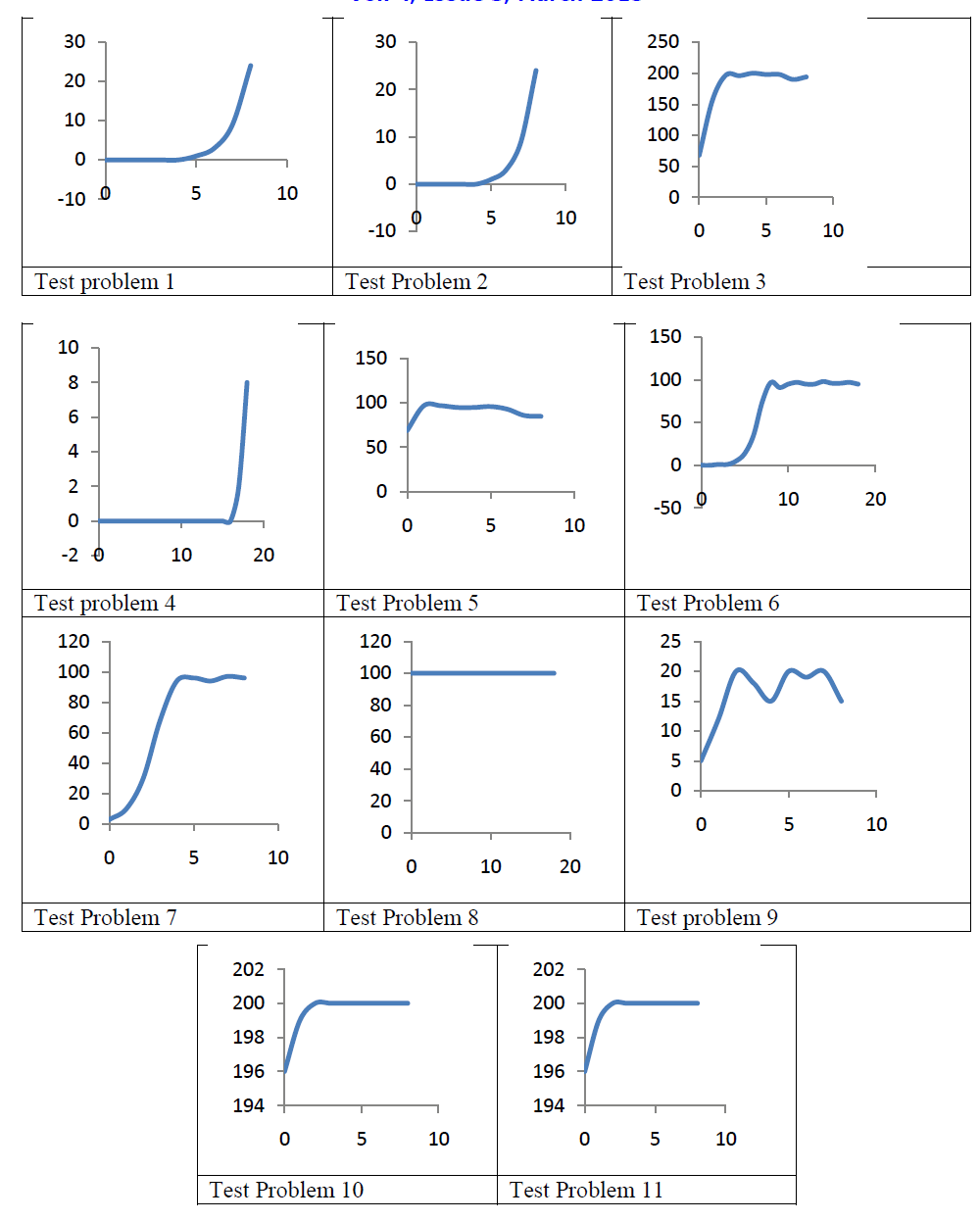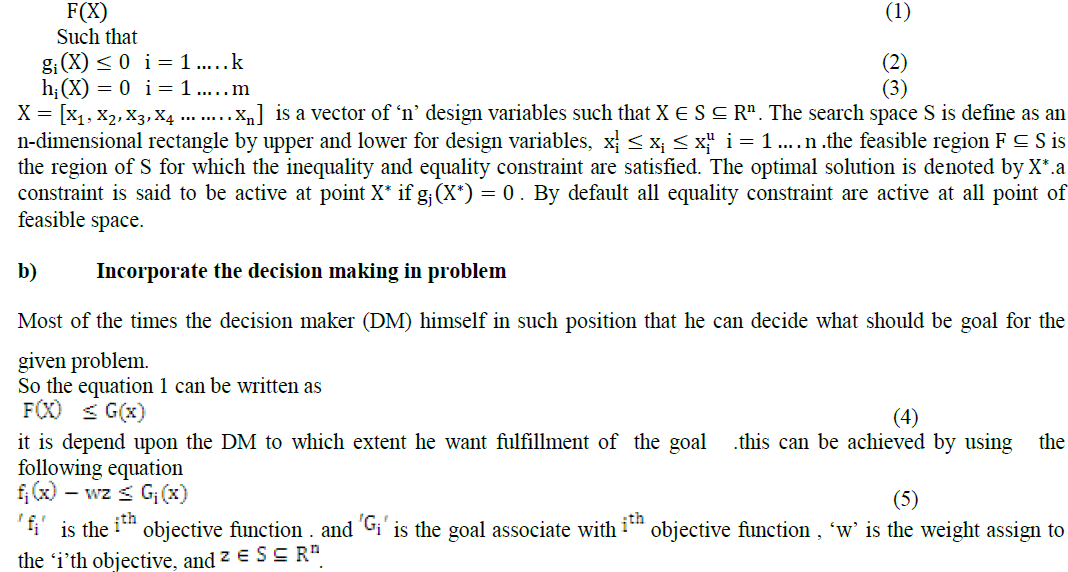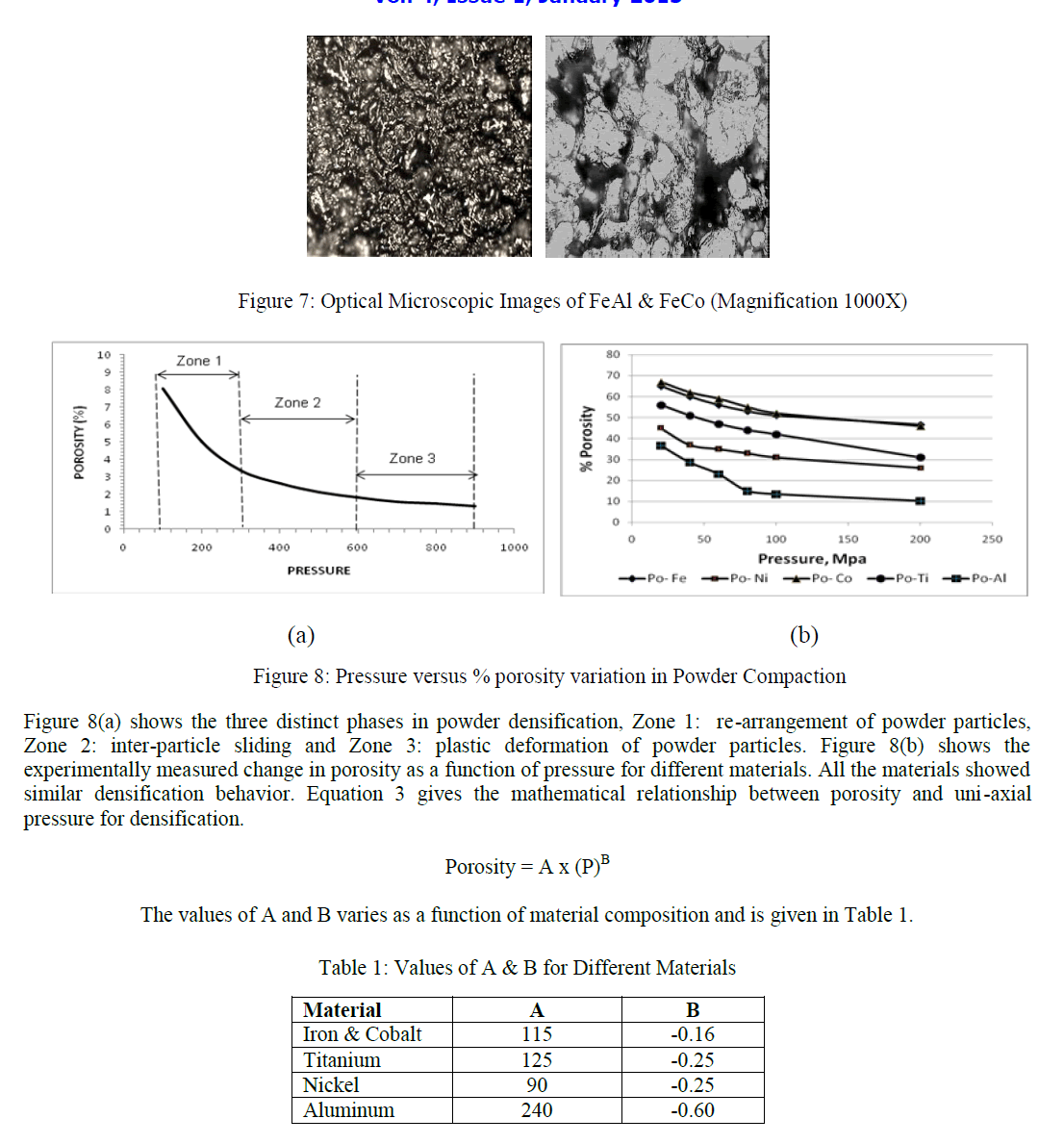ISSN ONLINE(2319-8753)PRINT(2347-6710)
ISSN ONLINE(2319-8753)PRINT(2347-6710)
Suresh K.R1, Mahendran S2, M.S.Krupashankara3 and Avinash L1
|
| Related article at Pubmed, Scholar Google |
Visit for more related articles at International Journal of Innovative Research in Science, Engineering and Technology
Powder Metallurgy (PM) deals with products and processes which use raw material in the form of powders that are compacted into the required shape and size using suitable moulds. These compacted powders are called „Green Compacts‟. The properties of the component produced by PM processes are influenced by powder characteristics such as composition, morphology, particle size, distribution, and method of compaction. The first step in PM process is preparation of „green‟ compacts. Uni-axial pressing is one of the most widely used compaction method for the preparation of green compacts. The process is characterized by three distinct phases namely re-arrangement of powder particles, inter-particle sliding and plastic deformation of powder particles. In this paper the effect of metal powder composition, particle morphology on „green‟ density under uni-axial pressing is presented. Iron powders with average particle size in the range of 2 to 150 microns show a linear relationship between green density and pressure. Green densities greater than 75% can be achieved with a pressure of 500 MPa. Micron size aluminum, nickel, titanium cobalt and iron powders were compacted under 200 MPa pressure to evaluate the effect of composition. Aluminum had the highest green density of 90%, followed by nickel at 75%, titanium at 65% and iron, cobalt at 55%. The three distinct phases of powder densification, mentioned earlier, were clearly observed in the porosity versus pressure plots for all the powders
Keywords |
| Powder metallurgy, Green density, Green Compacts, Powder Morphology, Composition, Uni-axial Pressing, Porosity. |
INTRODUCTION |
| Cold compaction is the first step in giving shape to powders in PM processes. There are different methods of cold compaction, such as uni-axial pressing, cold isostatic pressing, bi-axial and tri-axial pressing, metal injection molding, explosive compaction and hydrostatic pressing [1]. However, uni-axial pressing is the simplest and most widely used process for preparation of green compacts. |
 |
| Figure 1 is a schematic of the steps involved in uni-axial pressing. In stage 1, the particles get re-arranged with substantial increase in green density. In stage 2, which begins at higher pressure, individual particles are deformed and in stage 3, cold welding occurs between particles providing dimensional stability and green strength required for easy handling and further processing. |
| Green compacts can be prepared with or without binders depending on the composition of the elemental powders and subsequent sintering process. Higher green strength results in more robust handling of green parts prior to the sintering operation and reduced levels of green scrap. The benefits of using binder lubricant treated and binder-treated mixes show substantial improvements in flowability, segregation, resistance, green strength and compressibility [2-3]. Powder metallurgy enables producers to create mixtures of elemental powders with properties targeted for specific applications and to near net shape. The bonding of powders having different chemistry, particle size and shape is a very delicate and sensitive science [4]. The effect of powder morphology of elemental iron powders on green density using uniaxial pressure has been investigated [5] in the pressure range of 100 to 350MPa. The authors have reported a linear relationship between green density and pressure within the above mentioned range. Rodchenko.A.K.[6] has proposed different mathematical models relating apparent density, green density, compaction pressure, composition and green strength, clearly demonstrating the complex interaction effects that theses parameters have on each other. A.O.Kurt [7], has investigated and reported that there is no significant influence of rate of pressing from 2 to 14 mm/min for a maximum pressure of 550MPa on green density of iron powders with particle size in the range of 40 to 150 microns. However the micro-hardness increases from 80 to 130 kg/mm as a function of green density. Cam-Clay model is one of the most widely used models by researcher [8,5] to describe the densification process of metal powders. Iron and copper powders have been used as representative powder materials to demonstrate that the model can describe the densification of metal powders. |
| One of the major advantages of PM processes is the control on composition. PM processes can be used to produce special alloys, intermetallic and metal matrix composites. Sridhar [9] has studied and reported the effect of SiC reinforcement in aluminum matrix using a tri-axial test setup on green density. The authors have reported that finer the particle size of reinforcement phase higher is the green density. Cobalt-Nickel Oxide (metal: ceramic) composite with a weight ratio of 1:1 was mixed and densified using high pressure torsion setup by Menendez.E. et al [10]. Torsion loading generates shear and is extremely beneficial for plastic deformation of powder particles, which results in high green densities. |
EXPERIMENTS |
| Iron, Cobalt, Nickel, Aluminum and Titanium powders were procured from Ace-Rasayana (Loba Chemicals), Bangalore, Alfa Aesar, USA, GSM, Mumbai, J.J.Group, Bangalore. Chemical analysis and purity of the powders were as reported by the suppliers greater than 92%. SEM available at R.V.College of Engineering and Indian Institute of Science, Bangalore were used for characterization of powders for particle shape and size. Particle size distribution analysis was done using laser scattering particle size analyzer at AIMIL Instruments, Bangalore. The green compacts were prepared using a 10 Ton double acting uni-axial hydraulic press, using stainless steel moulds. The diameter of the green compacts was 25 mm with a thickness of 12 mm as shown in Figure 2. The green compact dimensions were kept constant for the present study and no lubricant was used. The green density of the compact was determined using weight / volume ratio. Electronic balance with 5 mg accuracy was used to measure the weight of the elemental powders and also the green compact. The volume was computed by taking dimensions using a digital vernier caliper with an accuracy of 0.01mm. Spring back effects of green compacts have been recorded but not discussed in the present paper. Optical microscope was used to study the microstructure of the green compacts. |
 |
| The high surface area and spherical iron nano powders with APS of 50 nm are produced by thermal decomposition of iron carbonyl. The combined effect of powder morphology and pressure on green density of iron powders are shown in Figure 4. Iron nanopowders show distinctly lower green densities, nearly 50%, compared to micron size iron powders. The iron powders with APS greater than 2 micron show a linear relationship; given in Equation 1, between green density (GD) and applied compaction pressure (P) even though the powder morphologies are different. The GD Vs P relationship of iron nanopowders follows Equation 2. |
 |
| Figure 6 shows the bar chart of green density as a function of composition. NiAl, TiAl and FeAl show higher green densities when compared to FeCo and FeNi. Primarily because of the soft aluminum phase that is present. The green density of the mixture of elemental powders does not necessarily follow the rule of mixture for determination of densities. The composition of the elemental powders has a stronger influence rather than the individual green densities of the materials. Figure 7 shows the optical microscopic images of FeAl and FeCo. The pictures clearly show that FeAl has less porosity compared to FeCo, which are hard materials. Aluminum undergoes plastic deformation at lower pressures and fills the gaps between iron particles resulting in higher densities. The presence of aluminum gives luster and therefore the microscopic image is brighter compared to FeCo. |
 |
| Figures 5 and 8(b) clearly shows that the critical pressure of compaction is 70MPa, this pressure is sufficient to ensure re-arrangement of powder particles, resulting in greater than 40% green density for all the materials in the present study. Step 2 or Zone 2 of powder densification begin beyond 70MPa and extends upto 200 MPa, this zone is dominated by interparticle sliding. The degree of interparticle sliding and the resulting increase in green density is a function of composition. In case of aluminum the green density reaches nearly 90% and in case of iron it is 53%, correspondingly the porosity in the green compacts are 10% and 47% as shown in Figure 8(b). Step 3 or Zone 3 requires very high pressure to plastically deform powder particles. Figure 4(a) shows pressures of up to 550MPa on iron powders, which can result in green densities of 75% or higher. |
CONCLUSION |
| The properties and performance of PM parts are directly related to density; therefore high green density of powder compacts is an important first step. For powder particles in micron range, pressure and material composition are the dominant factors that affect green density. Particle size and size distribution factors have minor effect on the green density. Using uni-axial pressure in the range of 500-600 MPa it is possible to achieve green densities of 75% or higher, irrespective of the powder composition. The powder densification behavior of nano-sized powder particles are distinctly different, requiring further investigation. |
ACKNOWLEDGEMENT |
| The authors would like to thank Naval Research Board (NRB), India. This work is part of the NRB funded research project on “Development and Characterization of Nano-metallic Magnets for Naval Applications” (NRB-144). |
References |
|